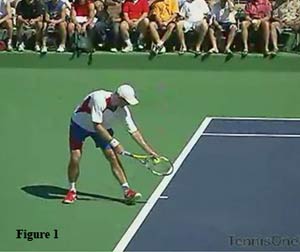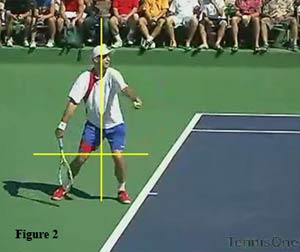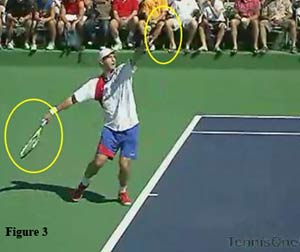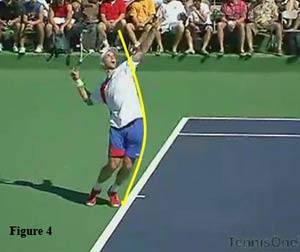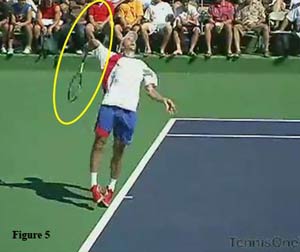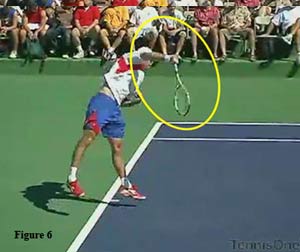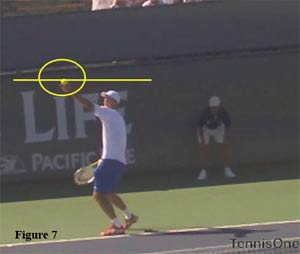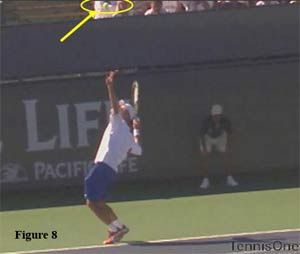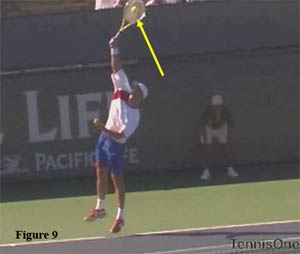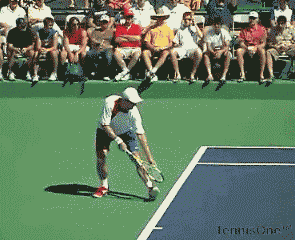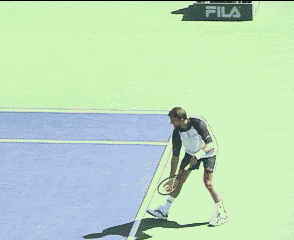|
TennisOne Lessons Ivan Ljubicic – Lower the Toss and Serve Tall Jim McLennan
Ivan Ljubicic turned pro in 1998, and has firmly established himself within the men’s top ten. He has been ranked as high as number 3, and is currently ranked number 7. He holds wins over every other player in the top ten including Roger Federer (though this was in 2003 before Roger really hit his stride), Rafael Nadal, Andy Roddick, Nikolay Davydenko, Fernando Gonzalez, Tommy Robredo, Novak Djokovic, James Blake, and Tommy Haas. This is an amazing record against the best players in the world, and much of his success can be attributed to his serve and the ability to back it up with punishing groundstrokes. Over the years quite a few players have built their service games around the “one two punch” of a big serve and groundstroke winner off the opponent’s return, but to my mind Ivan’s service motion recalls some big servers from back in the day. Goran Ivanisevic, Roscoe Tanner, and Kevin Curren all served with a low toss and relatively quick motion (though Tanner and Curren more often followed their serves to the net and both interestingly were Wimbledon finalists) and there is much about this type of serve that deserves a deeper look. The following Ricoh match statistics provide insight into Ljubicic’s consistent play. He leads this year in aces, he ranks second in service games won and first serve points won. It does; however, appear that the guys do have a chance when he returns serve (imagine combining the Ljubicic service game with the Murray return game – but that is another story).
Analysis of Ljubicic's Serve
In this first position (Figure 1), as Ljubicic addresses the court, his weight is back and his front toe is up, somewhat reminiscent of Pete Sampras. But to my eye this initial pose is simply an element of Ivan’s style, and not necessarily something that “all servers” should emulate. However, his weight is back, and he does appears poised to spring forward and up into the hit. As Ivan begins the tossing motion (Figure 2) he has become perfectly balanced, his head is directly over his feet, and his knees are evenly bent. For a player, whether professional or recreational, balance means everything during the toss as well as in the hitting phase. The next time you are on the practice courts, this is an excellent pose to copy.
At the release of the toss (Figure 3), Ivan begins to shift has back foot forward. His eyes are well up and the toss has been released from a point well above his head. Note the position of the racquet head, both down and closed. This is similar to the throwing motion of a pitcher or quarterback when they draw the ball (baseball or football) back with their palm down. As Ljubicic prepares to launch into the hit (Figure 4), he bows nicely, with his hips forward, his feet and shoulders are slightly back. The more he (or you) can move the hips across the baseline ahead of the shoulders, the more he (and you) can hit up and into the ball. With the back shoulder so low and the tossing shoulder so high, he is poised to cartwheel up and into the hit.
In the drop position (Figure 5), which used to be erroneously called the back scratch, Ljubicic's hitting elbow is up nearly head level, while the hand and racquet head are lagging behind. In a whip like motion he will pull the handle toward the sky, much like throwing a dart in a ceiling. The racquet head will lag as long as possible until he snaps it up against the ball. Much like all the photos of Pete Sampras show in the millisecond after service contact, Ivan has rotated his forearm and finished the stroke with the elbow up and the racquet head down (Figure 6). The inverted “V” of his forearm and racquet indicate extreme racquet head speed, as well as darn little energy in the follow through. Imagine snapping a wet towel against the wall (or a friend), in that action there is no follow through but rather an acceleration forward followed by a sharp snap in reverse. In this photo, imagine Ivan has snapped the racquet as though it were a towel.
The next three photos (Figures 7 - 9), shot in super slo-motion from the front, give us a glimpse of the release of the toss, the height of the toss, and how the ball lingers in the contact zone. Note how Ljubicic releases the toss (as shown in the side view as well) at a moment well above his head. Most recreational players release at a much lower point. When coaches implore these players to keep their tossing arms up, the issue is really the release point. If the arm moves slower, and the toss is held longer, the tossing arm will obviously be up and extended prior to the hit. I have circled the toss at it’s highest moment (Figure 8). Note Ivan’s balance, knees equally bent, and hitting elbow low while his tossing arm is well extended. Truly beautiful, and a pose that nearly all the best players routinely achieve. The difference here is that Ljubicic is not waiting for the toss to descend. He is in process of swinging up and into the hit as the ball lingers at the peak. Impact is perfect (Figure 9). Ljubicic is off the ground and his eyes are up. Note in a comparison with the previous still, the ball is only slightly below the peak, a mere inch or two. As regards serving tall, some suggest that his racquet should be higher, with the shaft vertical rather than off at a 45 degree angle from vertical. Actually, greater leverage is achieved when the racquet is out of line with the forearm, Pete had the same action at the top of the swing. And in this version, the racquet is actually snapping across the ball, rather than up and over the ball. At the professional level, there are many styles and varieties of serve. High tosses (Sharapova and Graf), low tosses (Serena Williams and Ljubicic), cautious sidespin (Dementieva), massive kick (Edberg), massive (Roddick) and placed with total disguise (Sampras and Federer). And you see the same variety at the recreational level - confident motions, muscular deliveries, all manner of grips, spins, and styles. But as much as anything, the toss may be the lynch pin of the serve, for the height influences the rhythm, and the placement influences the spin. My first coach, mentor, and wonderful old friend Blackie Jones often posed the following question (with both a stern look and twinkle in his eye), “When serving, do you prefer to swing at the toss or toss at the swing?” At this point there would be a considerable pause while I (or any other of his numerous students) pondered. At one level he questioned the relationship between the swing mechanics and the toss placement. At another level the question was about the relative role and importance of the toss and the swing, which was primary which was secondary. But further, the question asked was “when” one should release the toss during the service windup. If the toss is well above the point of contact, the server waits for a moment (or two) before swinging up to the ball. If the toss peaks at the moment of contact, the server swings more or less continuously throughout the motion without pause. And though certainly there are many ways to hit the ball, Blackie preferred tossing into the swing. His ensuing demonstration was a real “eye opener.” He would say that when swinging at the toss one may actually use varying mechanics to suit the variability of the toss, but when tossing at the swing the server was simply trying to get the ball in the way of the swinging racquet – and he would demonstrate this technique with his eyes closed.
The common misconception occurs when a player attempts to serve tall or to make contact when fully extended and reaching up for the ball. Somehow that message becomes “tossing tall” rather than “hitting tall.” And in nearly every instance when “tossing tall,” the server must wait, pause (Venus Williams like), and then resume the motion as the toss descends. Many servers have and will continue to use overly high tosses, but taking a look at Ljubicic or Ivanisevic; the case can certainly be made for tossing into the swing. Both toss the ball low, make contact fully extended, and serve with a quick explosive rhythm. Ivanisevic rode this delivery to a Wimbledon title, Ljubicic may have some big days ahead of himself as well. So how do you practice this type of motion, where are the challenges and what might be the advantages to you? Vic Braden has written extensively on this type of toss, and he shows that when the toss peaks within the contact zone, the ball lingers or remains within this area far longer than were it to descend from a height of 18 to 24 inches above the contact zone. Said another way, it might actually be easier to strike a motionless ball (think golf) than one that moves. Additionally, the wind creates less havoc with a lower rather than higher toss. But to get the hang of this type of serve, when becomes more important than how. Many of our youngest players learn the serve with a full motion and use a three count beat. Count one, the racquet starts swinging down, back, and up. Count two, the toss is released as the racquet approaches the “drop zone” (used to be called scratching the back but that phrase is both inaccurate and no longer in favor). Count three is the hit. One, two, three - swing, toss, hit. As with Ljubicic and Ivanisevic, all the mechanical aspects of the swing are identical to those players with a higher toss, the difference occurs with the rhythm. Serena tosses lower than Venus or Maria. Ivan tosses lower than Murray. And Roscoe Tanner, for those of you who can remember, tossed lower than perhaps anyone before or since. Lower the toss and serve tall. Your comments are welcome. Let us know what you think about Jim McLennan's article by emailing us here at TennisOne.
|
||||||||||||||||||||

